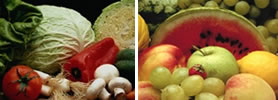Food consumption
It is important that you eat a balanced and varied diet.
Eating the recommended number of serves from each of the food groups, including a range from within each group, will help supply you with the essential nutrients and active non-nutrients you require to maintain good health.

Many phytochemical give plants their colours. Including a variety coloured fruits and vegetables in your diet supplies your body with a variety of phytochemicals.
Links
- http://www.health.gov.au/internet/publications/publishing.nsf/Content/nhsc-guidelines~aus-guide-healthy-eating
